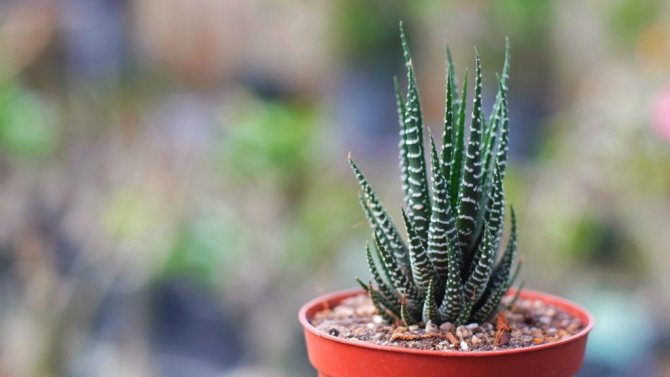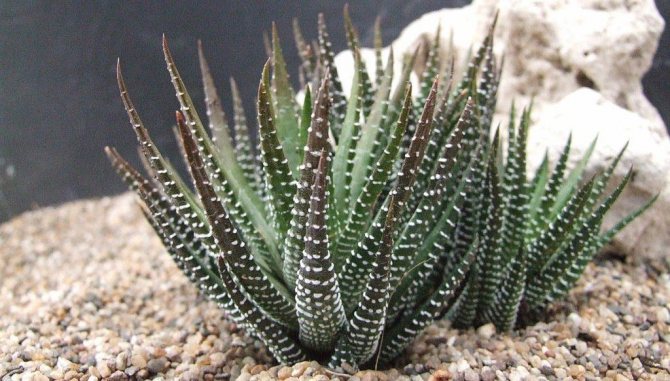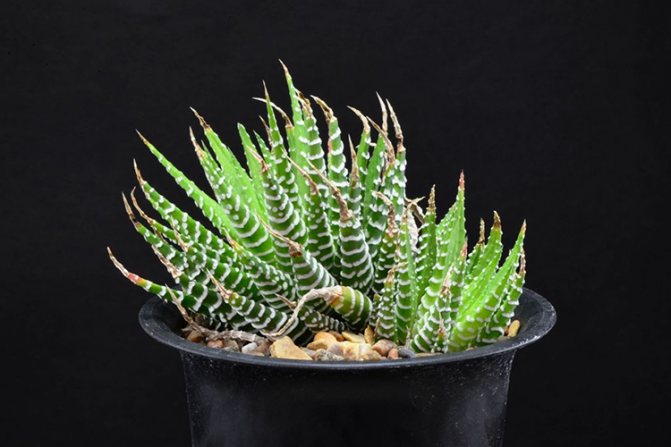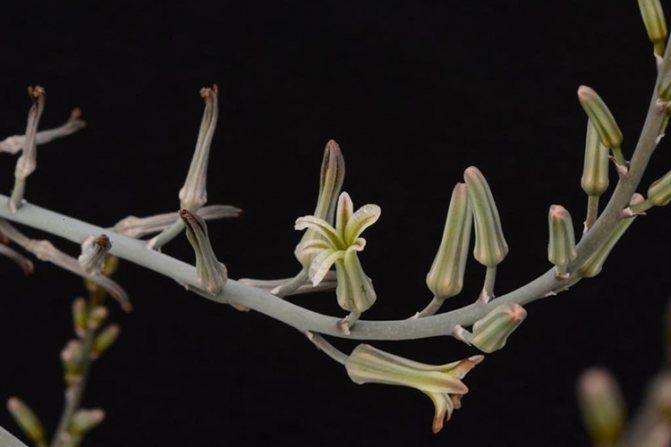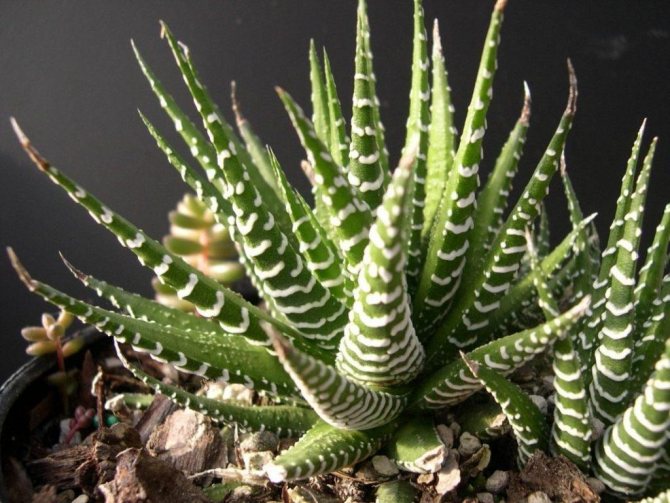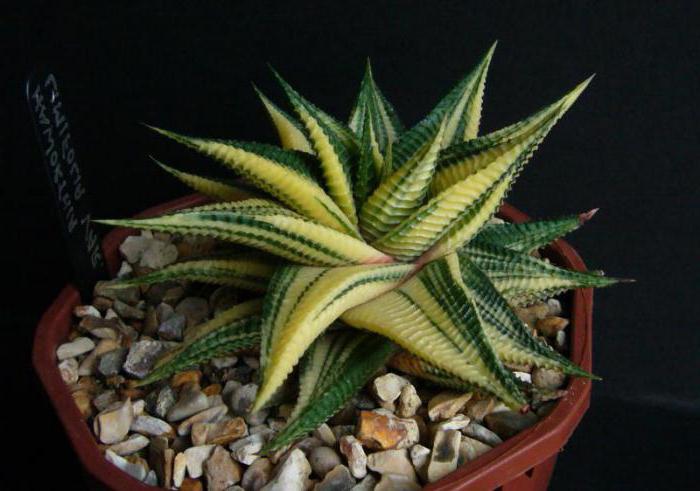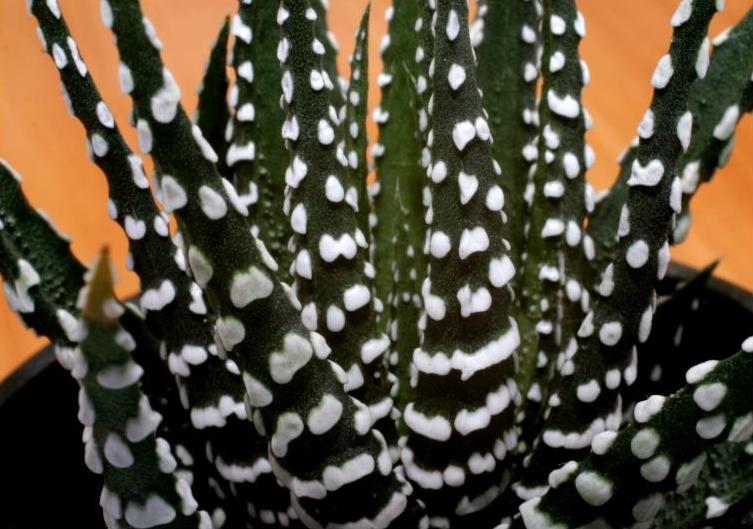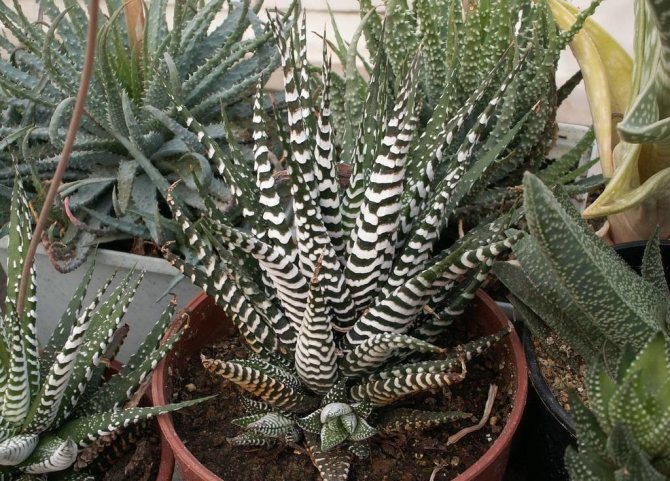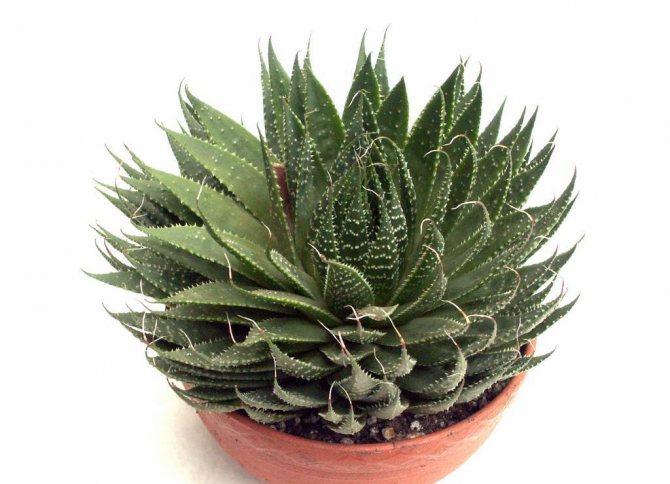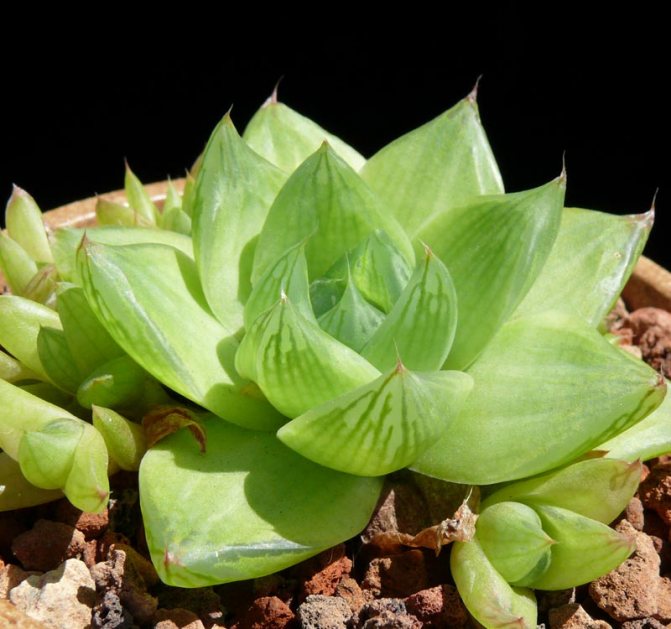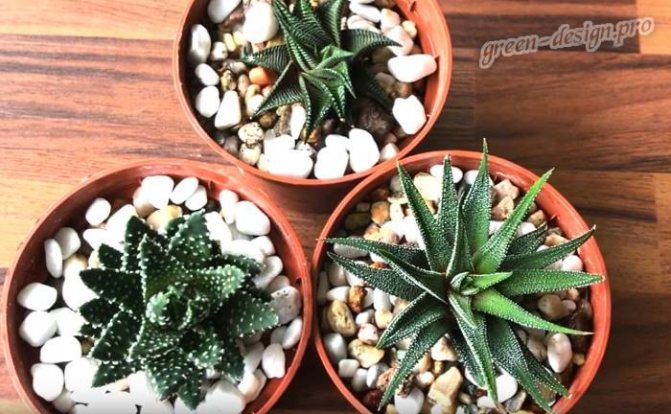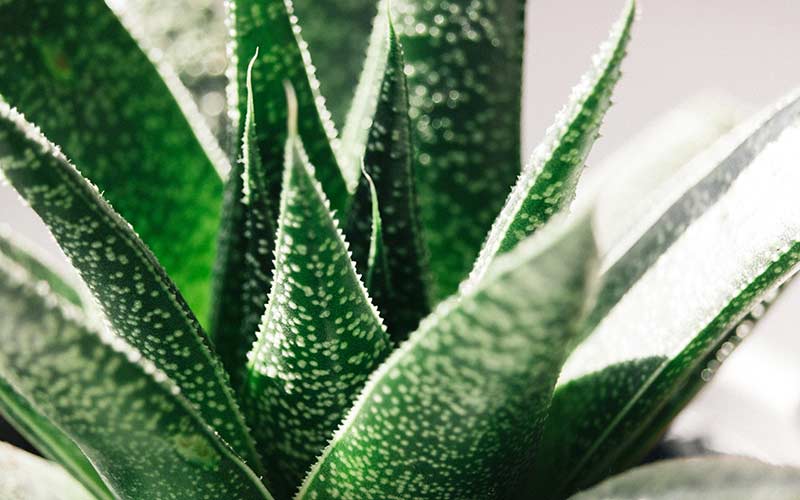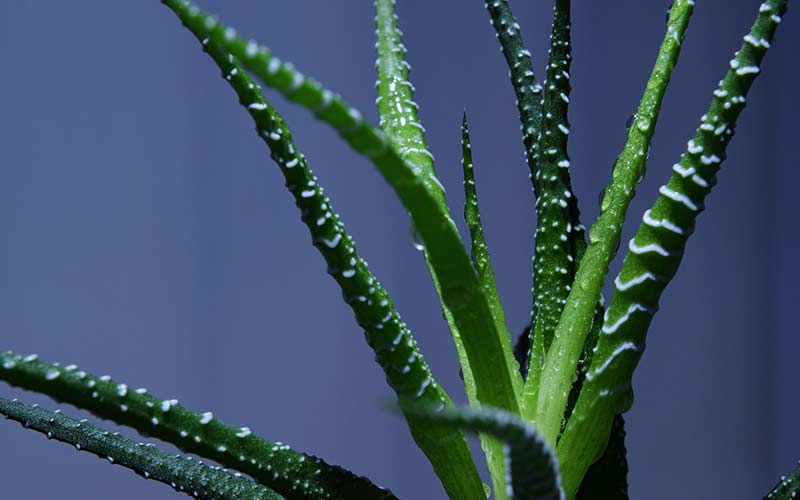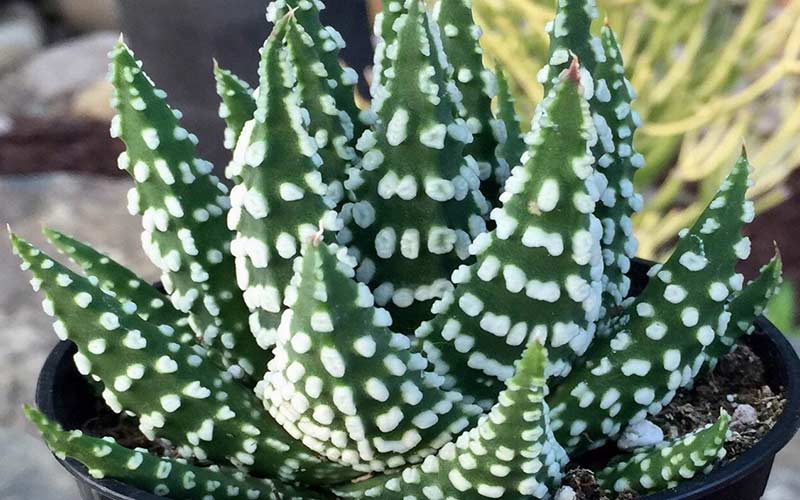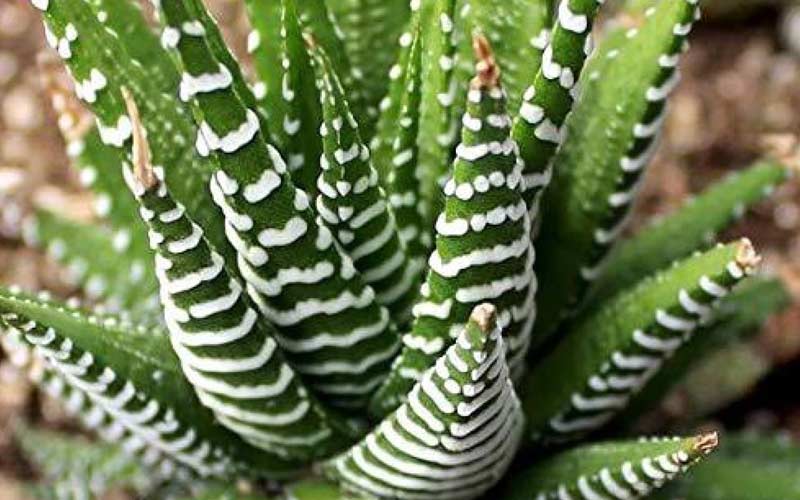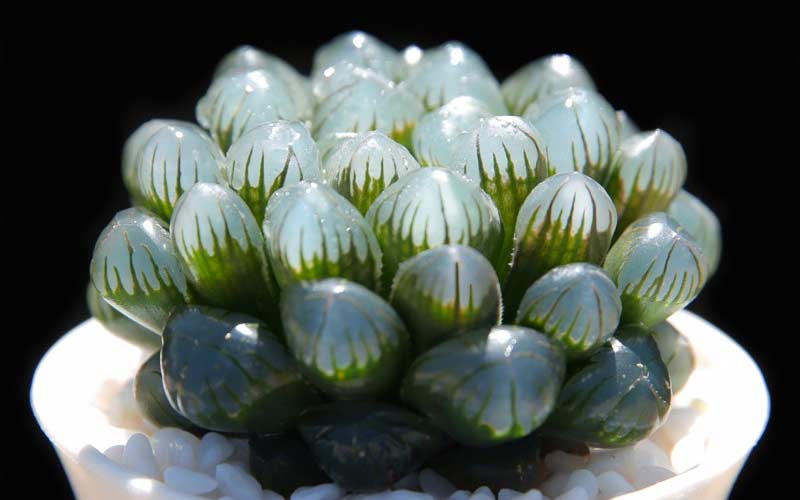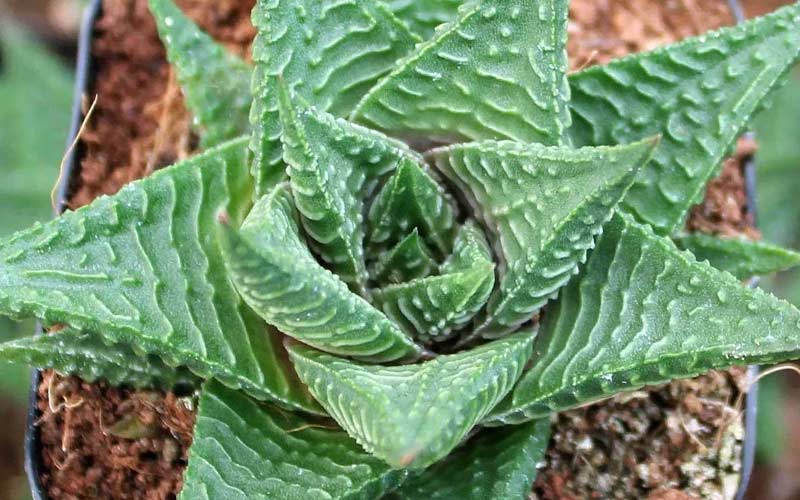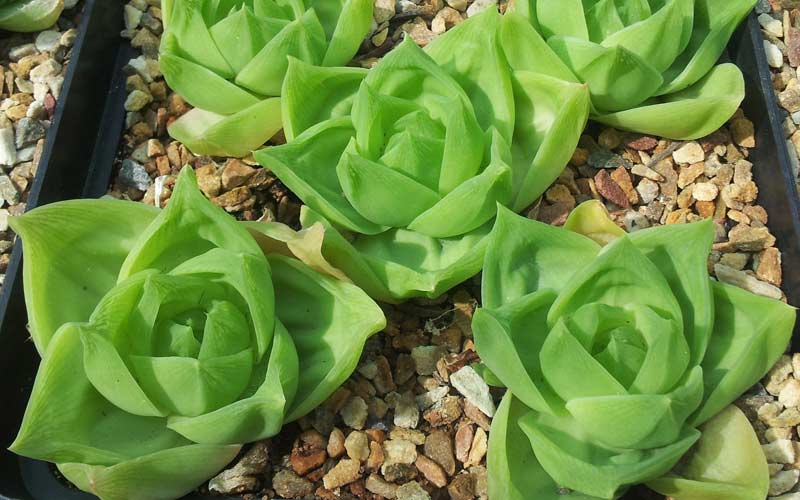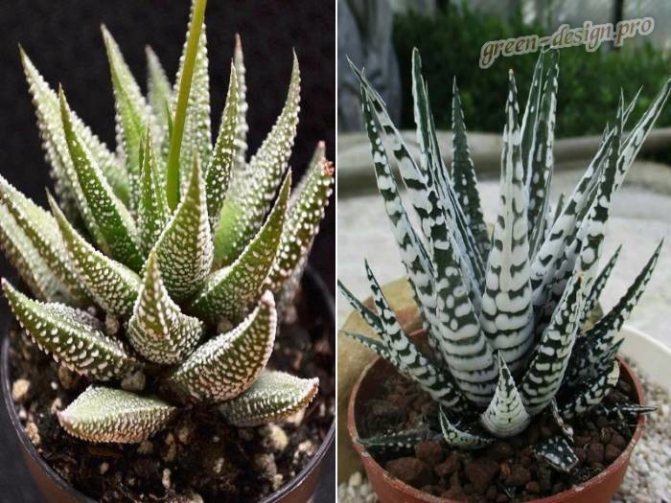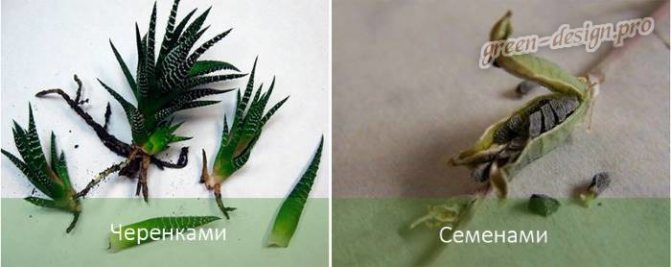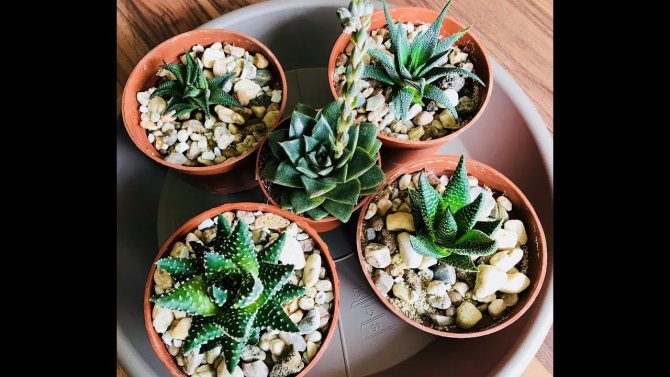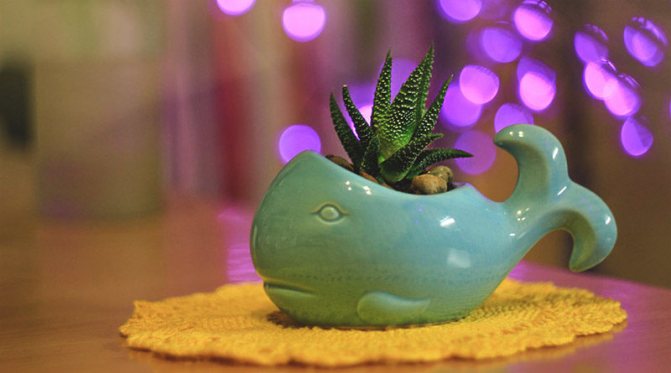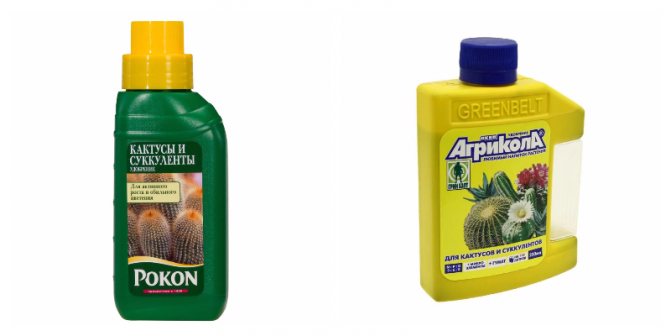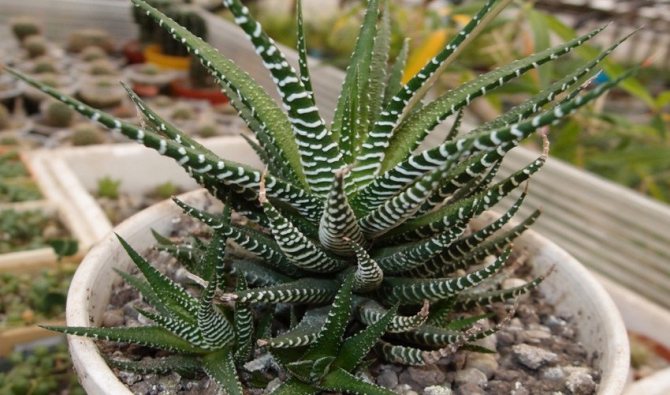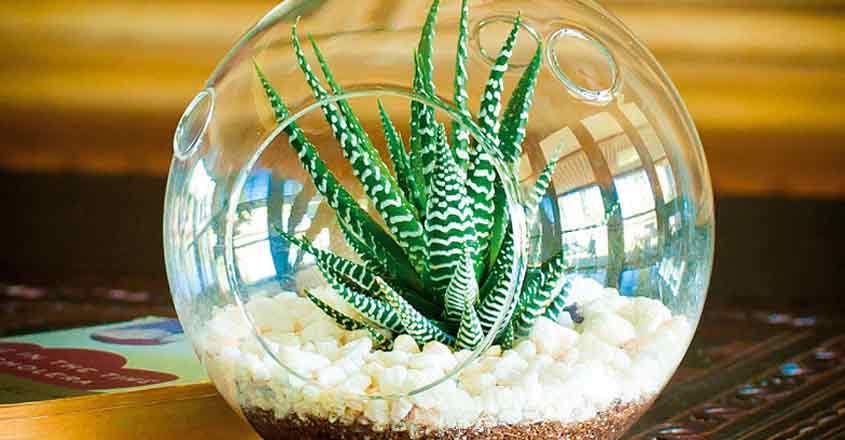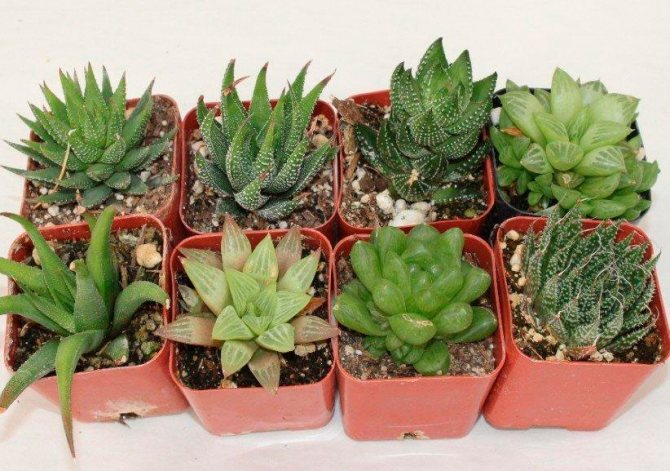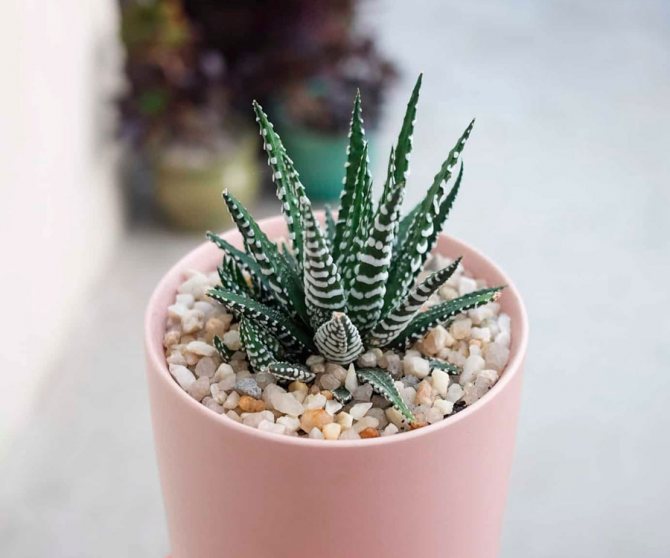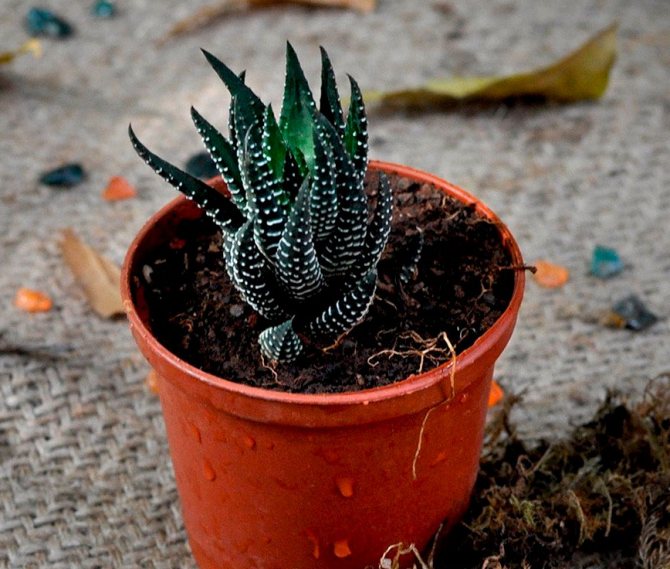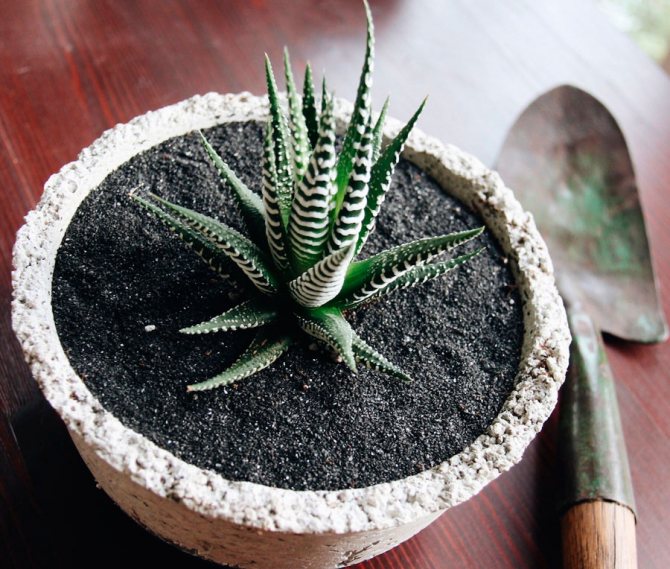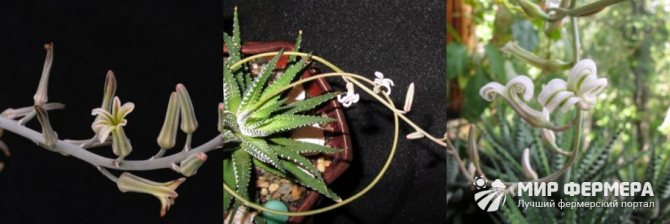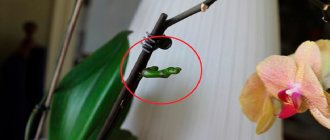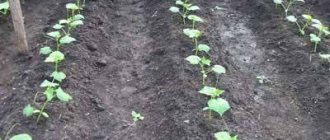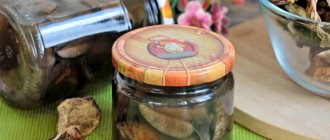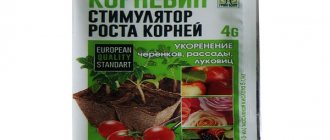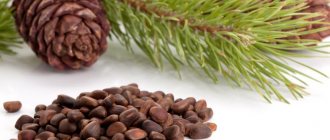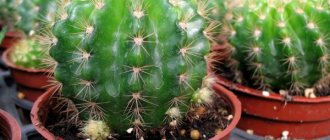Posted in Succulents, Care Published 02/04/2019 · Comments: · Read: 16 min · Views: 2 812
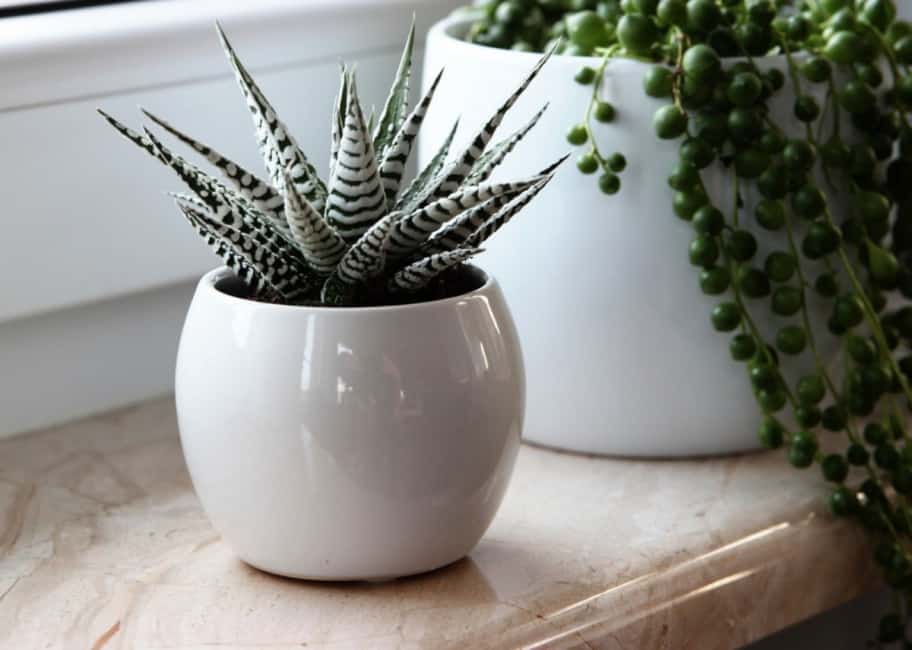
Haworthia striped is a popular, although not the most spectacular succulent plant from the Asfedelov family. Despite the relatively modest appearance, Haworthias have a lot of advantages: they are able to fit into any interior, bringing exotic notes, look great in succulent collections, are unpretentious and undemanding. Thanks to the latter, these flowers can be grown by inexperienced growers and even propagated by themselves. What are the features of the maintenance and care of the striped Hawortia and other members of the genus?
general information
The name Haworthia refers to a whole genus, which includes herbaceous succulents from the subfamily of Asphodeloids. Initially, the Asphodelics were a separate family, but today they have joined the Xantorrei family.
As a rule, we are talking about dwarf and miniature plants, many of which are successfully grown as indoor flowers.
These succulents are native to Southwest and South Africa, where they grow in arid regions, preferring shaded areas. They can be found under spreading trees, bushes, in grass, or under rocks. Sometimes these plants are completely in the ground and only the flattened tops of the leaves "look out".
It is interesting! The genus got its name thanks to the English botanist and entomologist Adrian Hardy Haworth. This specialist has described many species of both plants and insects.
Succulents have predominantly fleshy, dark green foliage that forms rosettes. They are located at ground level or only slightly rise, located on a short stalk.
Some varieties of haworthia look like rejuvenated. Many of them have transparent areas in the upper part - windows through which natural or artificial light penetrates even into the deep layers of tissues and rosettes.
Sometimes there are succulents, which have whitish warty tubercles on the leaves, resembling sugar glaze. Along the edges of the plate can be serrated, even, have "cilia" or long ostines.
Often, Haworthias are so fertile that compacted, pillow-like sod are formed from their lateral shoots. These compact succulents bloom more than modestly, with small flowers, they are similar in different species and do not differ in high decorativeness.
It is interesting! Often haworthia is mistaken for a cactus, and indeed, some of its varieties resemble these plants. However, although both are succulents, Haworthia is a member of the Asfedel family, not cactus.
Description of the plant
Haworthia is a short plant with a low growth rate. Most species form a basal rosette. They are similar to aloe, but more compact and showy due to the peculiar structure of the leaves and color. The color of the leaves varies from light to dark green, with bluish, silvery, brownish tints. The shape of the leaves is lanceolate, the surface is rough. Volumetric strokes and specks of white or dark green color give the plant a picturesque look. It is worth considering how Haworthia blooms.
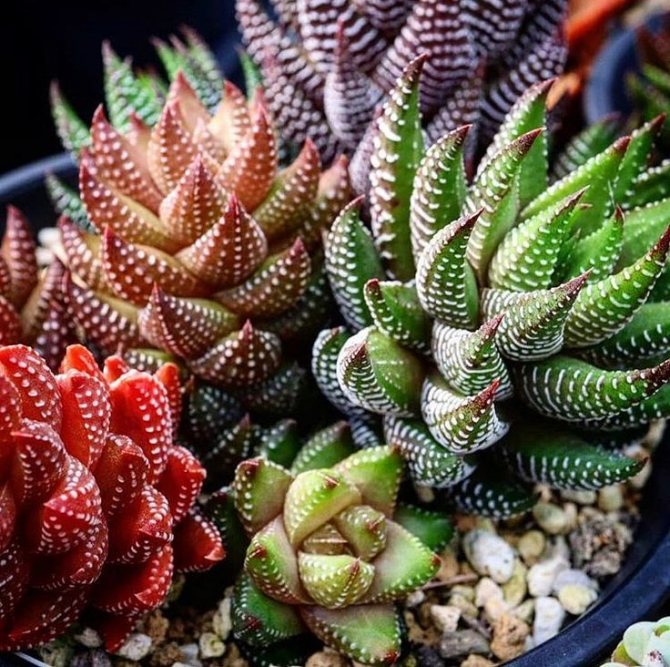

Composition from haworthia
Haworthia can bloom at any time, but more often it occurs in summer. Whitish small flowers appear on a thin peduncle. The flowering of haworthia is not of decorative value and in some cases the peduncles are removed so as not to weaken the plant.
Unpretentiousness allows you to use Haworthia for landscaping any interior. It takes up little space and grows slowly, therefore it is often used in succulent compositions in bowls and on rocky hills.
Additional Information! Haworthia got its name in honor of the English naturalist Adrian Hardy Haworth (1768-1833). He studied the flora and fauna of South Africa for a long time and made a significant contribution to science, describing the many plant species of this region.
Types of Haworthies
Haworthia striped is by no means the only representative of the genus; in fact, there are more than one and a half hundred of them. In home floriculture, the following types of haworthia are more common, which have both similarities and some differences:
- Haworthia striped (haworthia fasciata)
The succulent leaves have transverse growths of a light green or silvery hue, for which it was called striped. The flower is stemless, rosettes are formed from the foliage, their maximum diameter is 15 cm. During flowering, small white flowers appear on the fasciata peduncle, which resembles a twig.
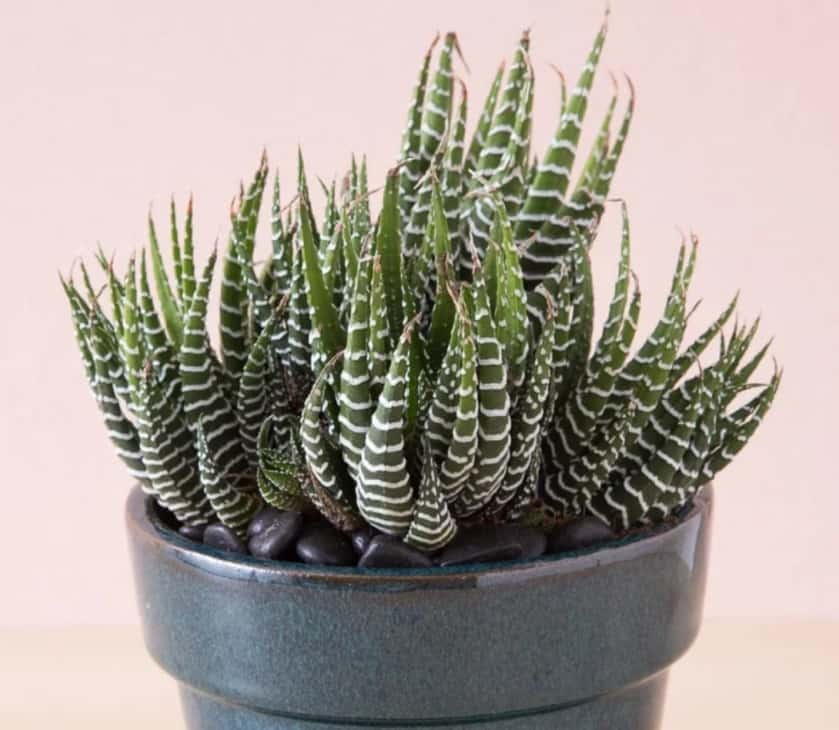

- Haworthia pearl (haworthia margaritifera)
On the fleshy oval-shaped leaves, noticeably swollen in the lower part and narrowed and curved in the upper part, there are whitish growths. They are located along the lateral edges of the leaf blades and are rather large in size.
During flowering, pearl-bearing haworthia throws out a 30–35 cm peduncle, on which there is a racemose inflorescence with small greenish flowers-corollas.
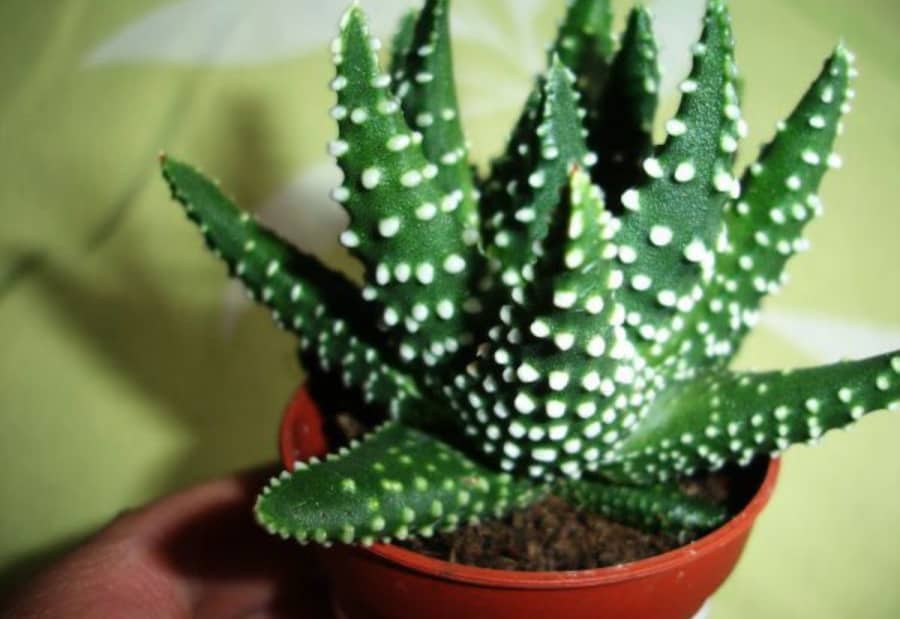

- Haworthia navicular (haworthia cymbiformis)
This succulent gets its name from the shape of the foliage, which resembles a boat. A compact rosette of a flower is formed from gray-green plates, its diameter does not exceed 10 cm. The leaves have windows covered with transparent skin, but there are practically no warty growths. This type of haworthia reproduces very quickly through vegetation.
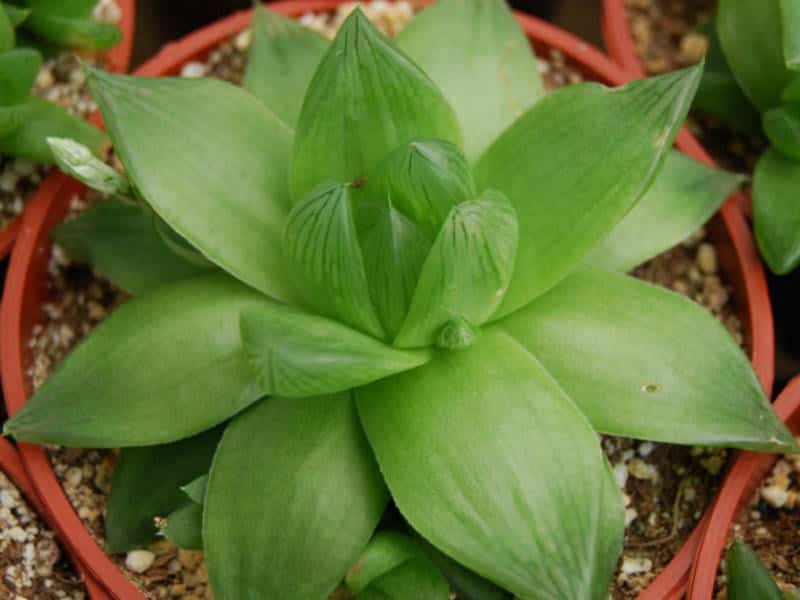

- Haworthia limifolia
The flower consists of symmetrical rosettes, consisting of fleshy leaves with pointed tips. They are covered with warty stripes located transversely. The drawing on the leaves is unique, since it is displayed almost 100% mirrored above and below. In terms of description and appearance, limolous haworthia is very similar to a starfish. The color can be bright green or dull.
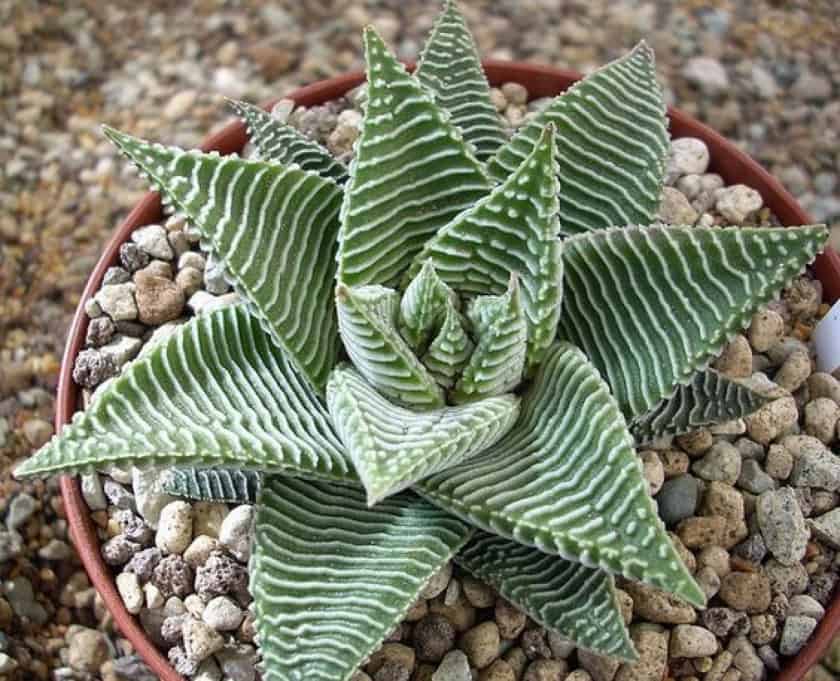

- Haworthia Cooper (H. Cooperi)
The succulent has small leaves with a rough surface, arranged in three rows. From below, the plates have a scaphoid shape, and from above they are depressed, the tops are bent back.
Like lithops, Cooper's Haworthia resembles pebbles, which is why sometimes this variety of succulents is called "living stones." Most often, this is the name for Cooper's variable havortia trunkatu, in which the tips of the swollen leaves are truncated.
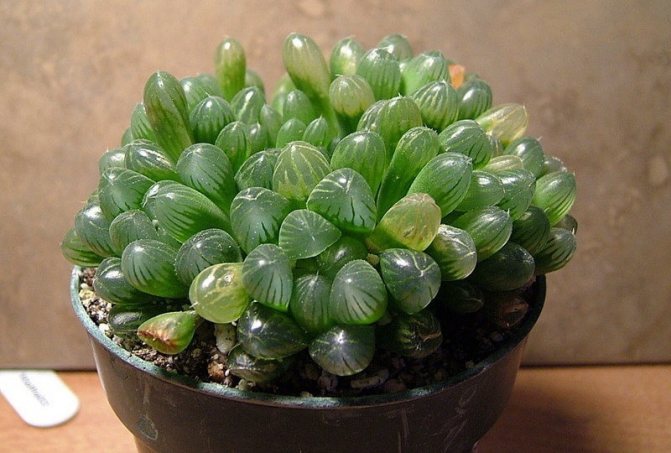

- Haworthia retusa (haworthia retusa)
A succulent plant with tough leaves, bent at the top and having three edges. The foliage color is solid green, there are also varieties with a red or brown tint. The length of the plates does not exceed 5 cm, they are decorated with light strokes and have transparent windows.
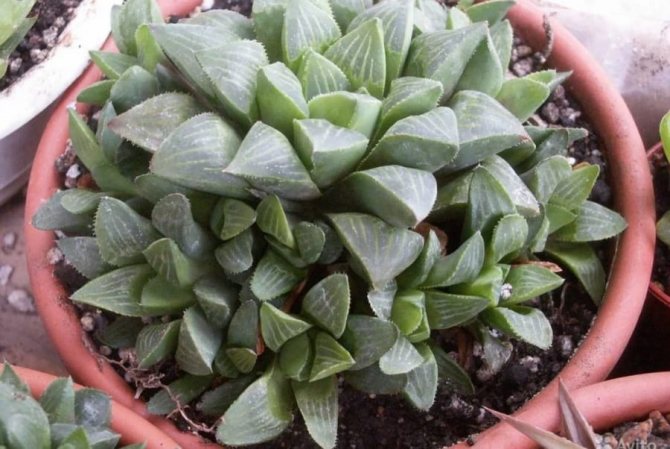

- Haworthia reinwardtii
Among other representatives of the genus, it is considered a rather tall species, reaching a height of 20 cm. A characteristic feature of the Reinward Haworthia is that its leaves grow from the shoot. They are triangular in shape, slightly concave inward, with pointed tips.On the plates there are grayish-white growths and the larger they are, the higher the decorative properties of the flower.
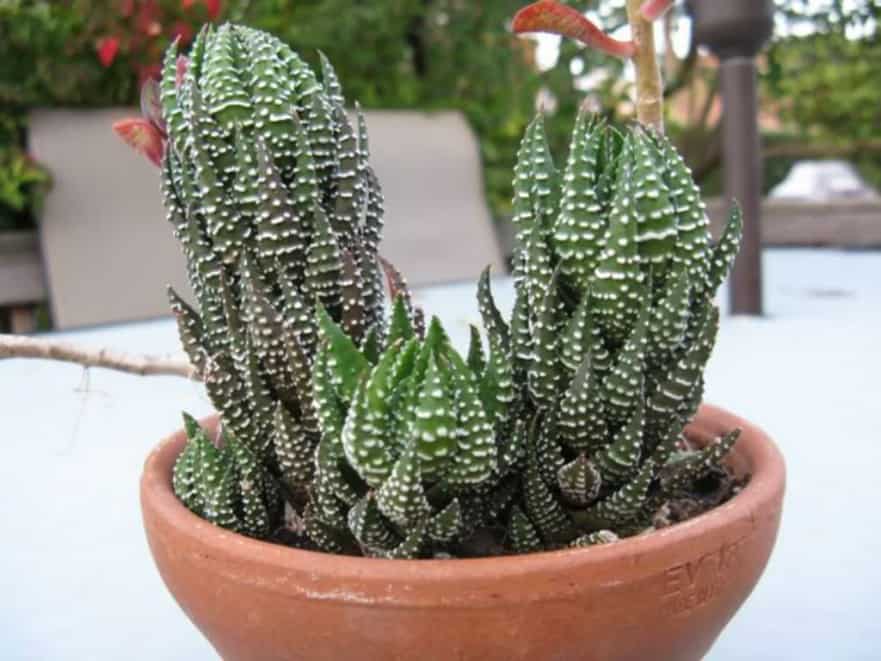

Since the haworthia family is quite numerous, it includes a much larger species of plants, and thanks to breeding work, many varietal varieties have appeared that amaze with their extraordinary shape and color.
Not all representatives have external similarities, however, they are similar in care and maintenance. Therefore, it is enough to know how to care for any of the haworthia in order to keep at home not only a striped beauty, but also a whole collection of these exotic flowers.
It is interesting! On sale you can find a plant such as Haworthia mix. In fact, this is a composition of several miniature plants planted in one container. Well-chosen flowers look very impressive together and get along well in one tank, and the florist gets several tropical beauties at once.
Varieties of culture
In the genus Haworthia there are more than 60 species, according to another classification - about 600. As indoor ornamental plants, varieties of different heights and colors are grown. The care for them is the same.
Types, name, short description:
- H. striped (H. fasciata) or haworthia fasciata - a rosette about 20 cm high is formed by long narrow green, sometimes with a burgundy tint, leaves with white outgrowths merged into transverse stripes;
- H. pearl or pearl-bearing (H. margaritifera) - a loose rosette (no more than 30 cm in height) rots after flowering, triangular leaves are covered with small pearl growths, large greenish-white or pure white flowers are formed on a long (about 40 cm) peduncle;
- H. Cooper (H. Cooperi) - in thick oval leaves covered with bristles, an elongated long tip, the upper part is translucent and transmits light well, the color of the lower part is different shades of green, bluish, pink, light brown, the peduncle is long (30 cm ), white flowers form an inflorescence-brush;
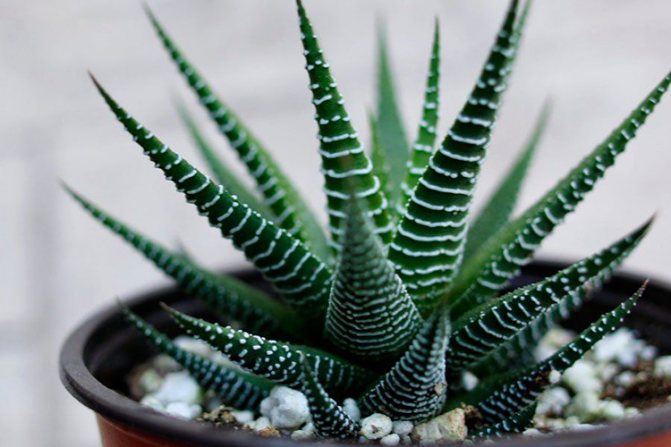

H. striped
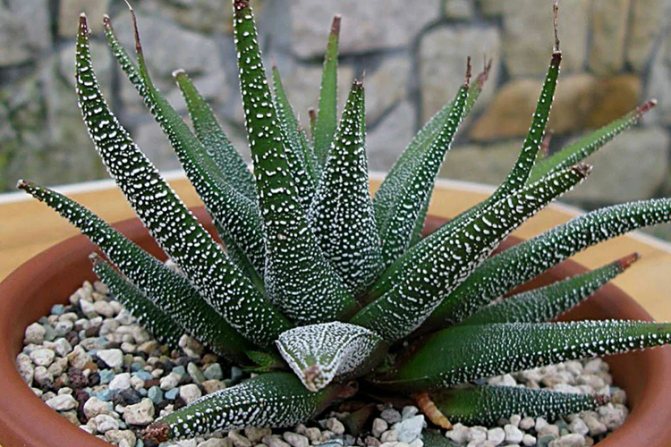

H. pearl
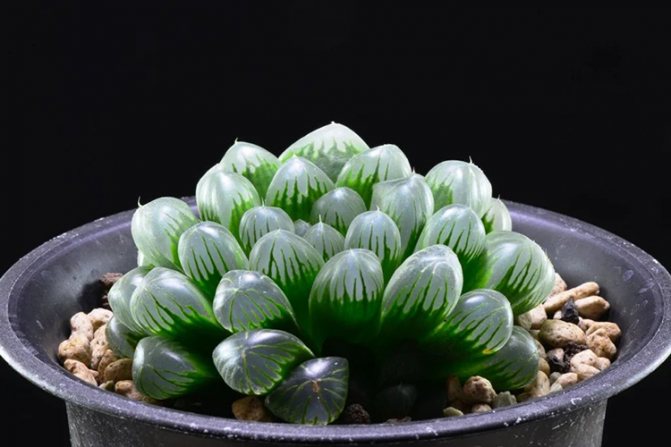

H. Cooper
- H. navicular (H. cymbiformis) - leaves of light shades of green, round or triangular-oval, with short spines along the edge of the ribs, there are translucent areas on the surface, the peduncle is short, the flowers are white or greenish;
- H. limifolia - convex transverse stripes are visible on the lower and upper surfaces of the lemon-yellow leaf with interspersed green;
- H. tortuosa (H. tortuosa) - in an adult plant, a stem is formed, densely covered with rounded greenish, light-burgundy, bluish triangular thick leaves, strewn with white small growths.
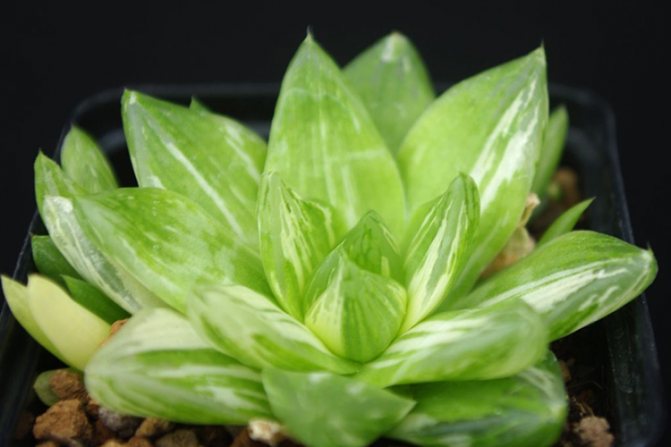

H. navicular
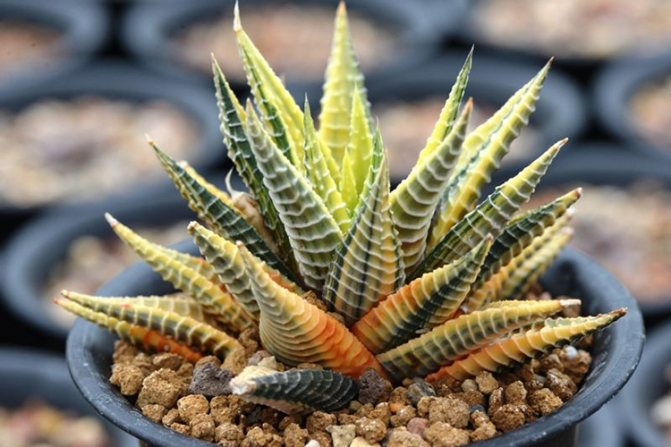

H. lemon-leaved
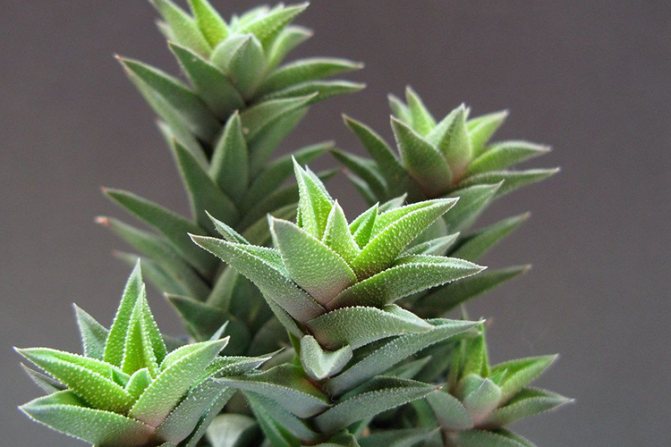

H. sinuous
Pot and soil selection
There are several soil mix options available for growing these compact succulents:
- Substrate without earth
Many growers prefer to grow their pets in a landless substrate, which is based on perlite, tuff, vermiculite or zeolite. In this case, any of the listed materials is mixed with the same amount of fine gravel, and then the composition is washed from dust.
Such soil is almost impossible to overmoisten, and due to its scarcity, the plants develop in it very slowly, maintaining their compact size and neat shape for a long time. Practice shows that in a landless substrate, haworthia develops a powerful, strong rhizome, and the aerial part of the flower becomes dense and squat.
- Peat mix
It is also possible to grow such succulents in a universal peat soil mixture, having previously added an equal amount of coarse river sand and perlite to it. Before use, the soil is recommended to be heat treated in order to disinfect.It is spilled with boiling water or ignited in the oven, I use it after it has completely cooled down.
The peat mixture is quite moisture-consuming, so you should adhere to the irrigation regime. It is nutritious, which means that the flower will grow quickly, while some specimens begin to stretch.
Self-preparation of soil mixture
The potting soil can be purchased at the flower shop when choosing a product for cacti and succulent plants. And also there is an opportunity to cook it yourself. In order for the mixture to have the desired consistency and not be dense, the following components can be mixed:
- 2 pieces of leafy land;
- 2 pieces of turf;
- 1 part charcoal;
- 2 parts coarse sand.
It is important to take into account that such soil is heavier than peat mixture and absorbs moisture better. Therefore, it is necessary to water the flower only after the topsoil dries out.
How to choose a pot?
Haworthias are best suited for wide, shallow reservoirs, in which they can grow in width for 2-2.5 years without needing transplants. The most suitable option is ceramic bowls, but pots from other materials are suitable for this purpose.
If the grower intends to grow one rosette, then a container with a diameter the same or slightly larger than the diameter of the plant is suitable for the flower. For mix-compositions of flowers, capacious reservoirs are used - bonsays, which can have a rectangular or round shape. As a rule, these pots are very beautiful and perfectly highlight the beauty of these unusual plants.
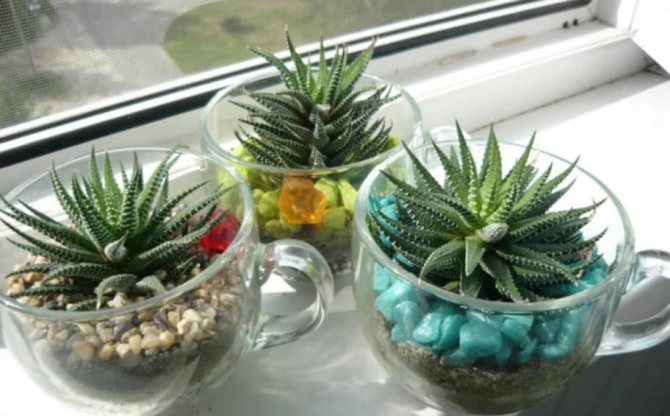

Problems with the maintenance of Haworthia and how to fix them
In the absence of proper care, unpleasant phenomena arise. They are eliminated by adjusting the content:
| The problem with leaves, etc. | Cause | Elimination methods |
| Sluggish to the touch. The plant is stretched. | Lack of light. | The pot is rearranged in a well-lit place, fed with any purchased mixture for cacti and succulents. |
| Curl up into a spiral, dry up from the ends. | Cold, perhaps the plant is in a draft. | The pot is rearranged to another place, protected from drafts. |
| Turn yellow or red. | Excess fertilizer, especially phosphorus-containing mixtures. | The feeding regime is being revised. |
| Shriveled, covered with brown spots, darkened. | Burn. | The affected leaves are removed. The plant is shaded. |
| Soft, watery, shapeless. | Excessive moisture. | Watering is stopped for 2 weeks. |
| Dark and rotten. |
| Rearranged in a warm place, the number of watering is reduced. |
| Stretched out, bent, the pattern blurred. | It's hot in the room. | The pot is transferred to a cool room. The room is often ventilated. |
Features of caring for a houseplant
Haworthia, especially some of its varieties, have a very original appearance and it may seem that caring for them at home is very difficult. But as it turned out, if you know the basics of growing succulent plants, then there will be no difficulties with this exotic vegetation.
Watering mode
Like other succulents, Haworthia does not like an abundance of moisture, so moderate and careful watering is encouraged. In the spring-summer period, moisture is applied no more than 1-2 times a week, but the soil is not shed abundantly, but only slightly moistened. Before the procedure, it is recommended to evaluate its condition, if it is wet, then watering should be postponed until the top layer dries out.
You can take tap water, but it must first settle for several days and be at room temperature.
As you know, succulent plants in nature are able to do without water for a long time, using the moisture stored in advance. However, pets should not create artificial droughts.A plant that finds itself in unfamiliar conditions will not be able to endure such changes.
It is important! Group planting requires more frequent and abundant watering than single plants.
Air humidity and room ventilation
Even if the indoor air is excessively dry, the Haworthia will feel good without any discomfort. It is not necessary to additionally increase its moisture content for this plant. But excessive humidity is dangerous for him and can even cause the death of a houseplant.
Do not wash or irrigate the flower from a spray bottle. To remove dust and dirt from the foliage, it is enough to wipe the plates with a damp cloth. This should be done very carefully, not allowing water to penetrate into the leaf sinuses or into the outlet.
It is impossible for the air in the room where the Haworthia is located to stagnate. To do this, it is enough to ventilate the room 1-2 times a week, for one to two hours. But, it is worth remembering that a draft for a flower is dangerous, which means that a pot with it should not stand at an open window.
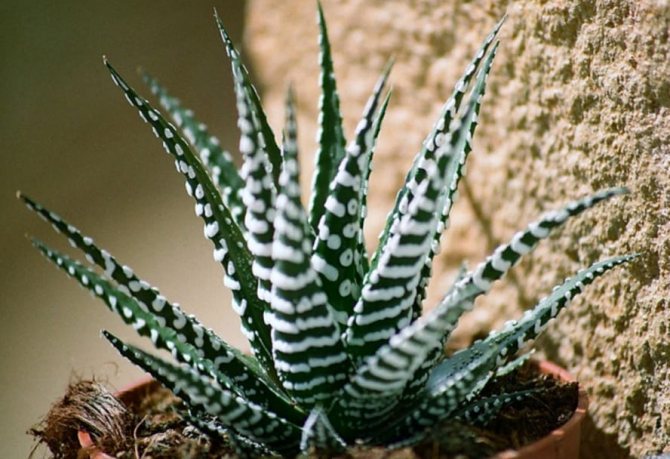

Fertilization
Hawortia is fed only during the active growing season - from early spring to October. From late autumn to spring, succulents rest and do not need feeding. You can adhere to the following recommendations:
- haworthia are more suitable for mineral compositions in liquid form, containing a complex of useful elements;
- top dressing is usually applied during watering, carefully into the soil, without affecting the leaves;
- for the full growth and development of a flower, one procedure in 4–5 weeks is enough.
The plant will tolerate the lack of nutrients better than their excess, so it is important not to overdo it.
Dormant period
Most succulent plants prefer to rest in winter and Haworthia is no exception. At this time, there is a slowdown in all vital processes of the flower, which leads to a change in its needs. Caring for Hawortia in winter should be as follows:
- the number of watering is reduced to 1 time per month, this is especially important if the flower hibernates in the cool;
- feeding for this period is completely canceled;
- for this time, it is advisable to place it in a room where the temperature is +10 - +15 degrees.
It is important! Wintering Haworthia is warm, at an air temperature of +20 degrees and above, much earlier it leaves a calm state and continues to grow. But, due to the lack of natural light, its leaves become smaller, which is why the flower loses its decorative effect.
Flowering features
When grown indoors, haworthia striped and other types of succulents rarely come into bloom. Only if kept in conditions as close to natural as possible. In this case, at the end of spring, the flower throws out peduncles-twigs.
The striped haworthia has small flowers on their upper part that do not have decorative effect. Actually, the flowering of these succulents does not cause much enthusiasm, so growers are not upset if this does not happen at all.
In addition, experienced haworthia breeders advise removing flower stalks when they appear, since they, having no decorative value, spend a significant part of the plant's nutrients.
It is important to take into account one more nuance - the flowering of some varieties of haworthia ends with the death of the mother plant. Usually it already gives many children, which it feeds until it dies completely. Therefore, it is not recommended to remove dying succulent sockets.
When the Haworthia blooms, you can pollinate the flower by manually transferring the pollen from the stamens to the pistils, and then the seeds are formed for subsequent planting. But, this process is so energy-consuming for the succulent that upon completion it often ends with the death of the flower.
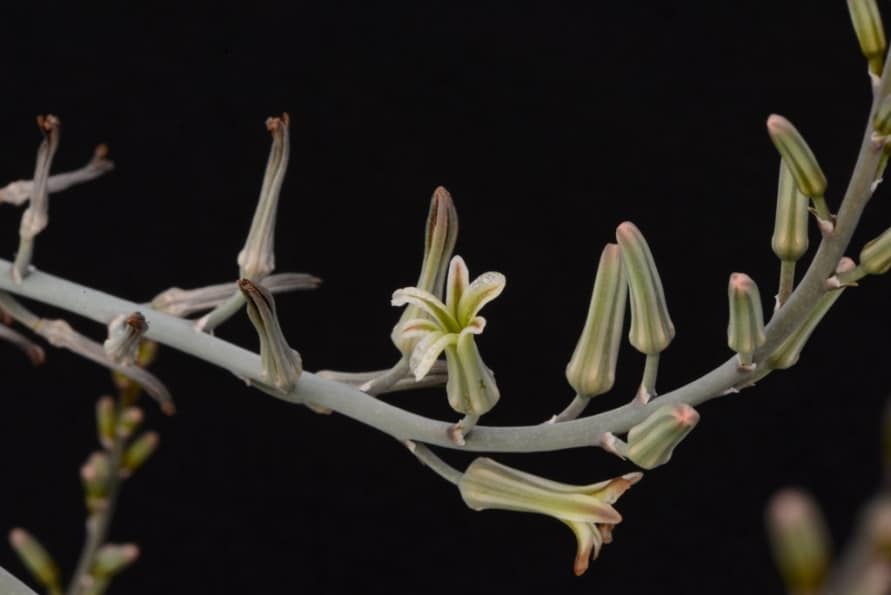

How to transplant Hawortia correctly?
The frequency of transplants depends on the age of the succulent, for example, it is enough to transplant young plants annually, adults need one move every 24–36 months. Usually this procedure is required if the haworthia rhizome becomes cramped in the old dwelling. If the event is not urgent, then it is recommended to plan it in early spring and for this you need to prepare the following:
- a new pot - slightly larger than the previous one; too spacious a haworthia reservoir is not needed, it feels more comfortable in cramped conditions;
- drainage material - it can be vermiculite, expanded clay, brick chips, broken ceramics or pieces of foam; a drainage layer at the bottom of the pot is required, it ensures the removal of excess moisture from the soil, does not allow it to stagnate;
- fresh soil mixture or landless substrate.
In some cases, a tool is required with which you can separate the children, for example, a knife with a sharp blade. But, more often than not, they are easily detached without additional devices. Before the procedure, it is recommended not to water the flower so that the soil can dry out. The haworthia transplant itself is carried out according to the following algorithm:
- Holding the soil, turn the container over and tapping on the bottom to remove the flower.
- If necessary, you can separate the children, clean the outlet from dried, damaged leaves.
- The remnants of the old soil are shaken off from the root.
- The rhizome is inspected for damage, rot, and dead roots. Such "illiquid" parts are removed.
- A drain is placed at the bottom of the new pot, filling 20 to 30% of the total. If a landless substrate is used, no drainage material is needed.
- The soil or landless mixture is poured in a slide, the rhizome is placed on it and the roots are carefully straightened.
- The remaining empty space is filled with soil to the level of the lower foliage.
- The top layer must be leveled and compacted a little. If he is a donkey, then the composition should be added.
A well-planted succulent does not stagger in the pot, and its roots do not peep out on the surface. If this happens, then it is recommended to deepen it more.
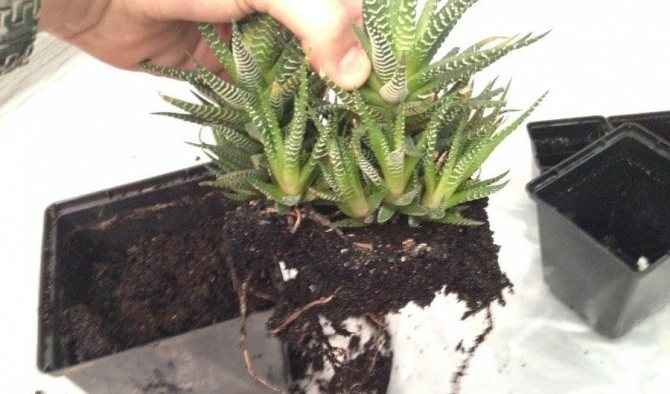

Transfer
It is important to remember that haworthia can be transplanted no more than once every 3 years. Usually by this time the roots have mastered the volume of the pot allotted to them. The optimal shape of the planting tank is wide and shallow. A small layer of drainage from broken bricks, small pebbles or shells is placed on its bottom.
Important! If the pot turns out to be too high, then instead of building up the above-ground part, the haworthia will tend to reach the bottom with its roots.
It will not be difficult to buy haworthia to your taste today. The popularity of its various varieties is very high and is not inferior to cacti or fat women. This plant is from the beloved category of many - "planted and almost forgot".
Reproduction of Haworthia
In order to propagate a succulent, you can use several methods: rooting cuttings, leaves or planting seeds:
Cuttings
The easiest way to reproduce haworthia, providing a high result. It is best to take side sockets with roots. They are separated from the mother bush and immediately planted in a pot with a moistened soil or landless mixture.
If the separated cuttings do not have roots and consist of 2-3 leaves, then it is necessary to sprinkle the cut with charcoal and leave it in the open air for 2-3 days to dry the cutting. Then it is sent for rooting, placed at an angle in wet sand.
After the formation of the root system, Hawortia can be planted in a separate container with a substrate.
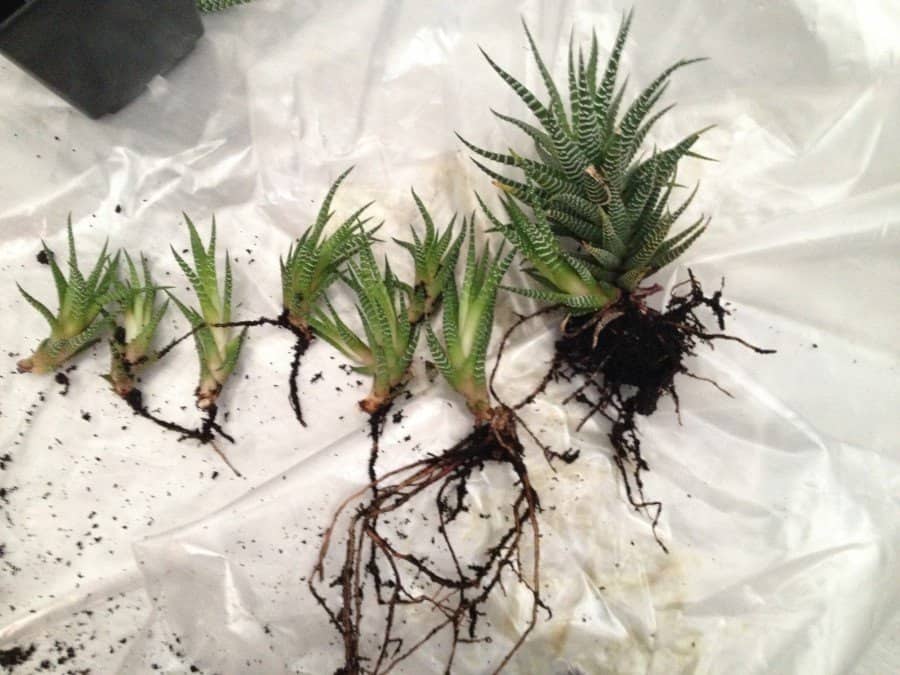

Rooting a leaf
A more troublesome way, since it is more difficult to grow a succulent from a leaf blade than from a cutting. As in the previous case, the cut leaf remains dry for several days in the open air. After this time, it is planted in a container filled with sand or loose substrate.
The planting is not watered until the leaf sprouts. You can only slightly irrigate the substrate with a spray bottle. It is not necessary to arrange greenhouse conditions, since with excessive moisture, the leaf will rot without taking root.
It is better to propagate haworthia in this way in the spring.
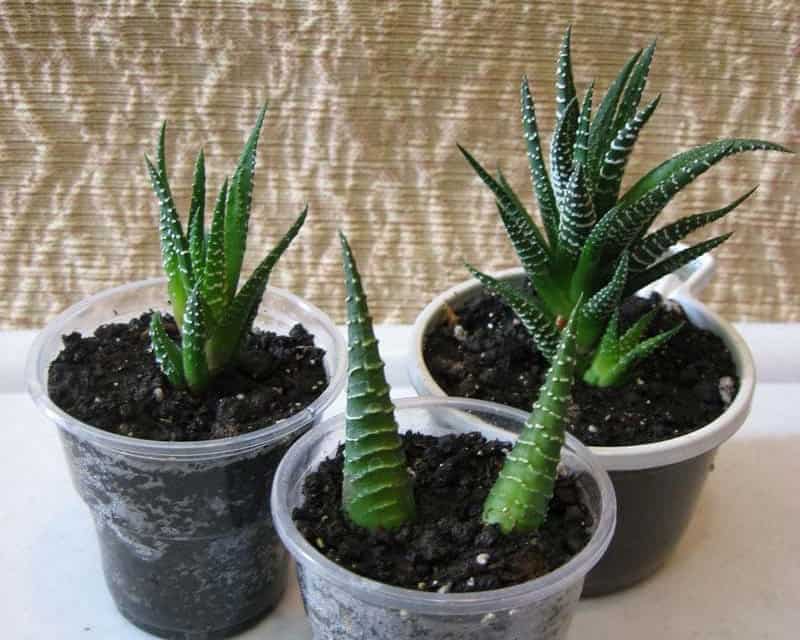

Planting Haworthia Seeds
This method is most often used by breeders who have a large store of knowledge and skills. The fact is that the seeds of Haworthia do not always germinate, even if they are purchased from a responsible seller or harvested from their own plant. The material very quickly loses its germination and even the freshest seeds sprout only 80%. And even if the seedlings appear, they often die in the first couple of weeks, and sometimes they cannot stand the pick.
If, nevertheless, there is a desire to grow haworthia seeds, then they can be sown at any time of the year, but it is better to do this in the spring. During this period, the seedlings will not need additional lighting:
- the seeds are placed on pre-sterilized and moistened sand or on a mixture of sand and leafy earth, and then pressed down a little;
- the seeding tank is covered with foil or glass and placed in a place with good lighting, but with mandatory protection from direct sunlight;
- the optimum air temperature is +16 - +20 degrees, deviations are permissible, but not lower than +10 and not higher than +25;
- when most of the seeds hatch, you need to remove the covering material, first for a while, so that the sprouts get used to it, and then remove it completely;
On average, the emergence of seedlings can be expected in 2-3 weeks, but the first sprouts hatch as early as 5-7 days. The sprouts should be regularly watered and sprayed, and they will be ready for transplanting into a separate tank only after 10-12 months.
Possible difficulties in growing haworthia striped
Haworthia cannot be called a whimsical indoor flower; it is not uncommon for almost lifeless specimens to enter a new house, which, with proper care, manage to fully recover. Most often, these succulents suffer from the mistakes of the grower.
Care and maintenance errors
The following violations can seriously undermine the health of even such persistent and unpretentious plants as haworthia:
- weak lighting - the flower loses its decorative effect, the rosettes become loose, and the leaves lose their brightness;
- content of succulent in the sun - can lead to foliage burns and discoloration, green plates turn brownish;
- lack of nutrients - the tips of the leaves dry out, the growth of haworthia slows down;
- excess dressing - the foliage loses its turgor, becomes yellowish or reddish.
Most often, to help a green pet, it is enough to eliminate mistakes and continue not to make them. As for diseases, they are also in most cases the result of poor or inappropriate care.
It is interesting! Haworthia is considered a protective plant, an energetic, which spreads its positive energy in the house. And if a succulent begins to grow poorly, then it is actively fighting negative influences and it lacks strength for itself. Perhaps, if quarrels and conflicts in the family diminish, this baby will have more energy for growth and development.
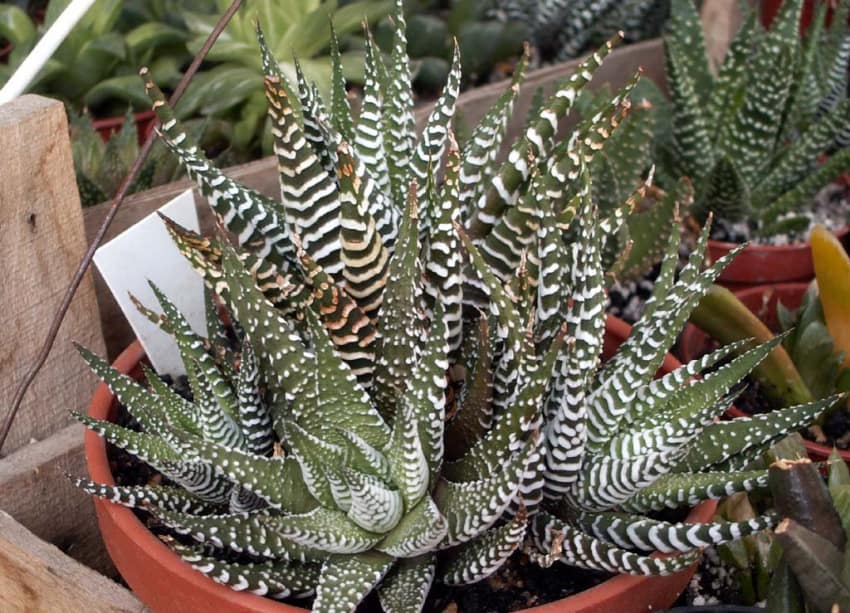

Domestic succulent diseases and treatment
Rot, this is why succulent plants often suffer, and often die:
Root rot
A dangerous ailment in which the root system of a flower suffers - it begins to rot, turns black. The main causes of the disease are waterlogging of the soil and hypothermia of the rhizome. To save Haworthia, complex therapy will be required:
- The flower must be removed from the pot and its roots must be examined.
- Cut off the rotten parts of the root with a calcined knife or scissors.
- Treat the remaining rhizome with a fungicidal preparation.
- Slices are sprinkled with crushed activated charcoal or charcoal.
- The substrate is sterilized and the treated plant is planted in it.
To eliminate the likelihood of root rot development, it is necessary to adhere to the watering regime, avoiding waterlogging of the soil substrate. If homemade soil is used, it should be sterilized before use.
Gray rot
The main signs of the disease are the appearance of ash-gray spots on the leaves of the Haworthia and the subsequent softening of the affected areas. Treatment of a flower consists in treating it with a solution of foundationol or a mixture of 2% soap solution with 2% copper sulfate. After 1.5 weeks, a second procedure is performed.
Preventive measures include providing the plant with good lighting, regularly ventilating the room, and removing diseased foliage.
About pests and getting rid of "uninvited guests"
Like other succulents, haworthia can infect aphids, spider mites, scale insects, thrips, and worms. All insects parasitize the plant, feeding on its vital juices, and some of them also attract other pathogens.
Spider mite
If there is a wiggling mass at the tips of the leaves and the flower is framed by the thinnest cobweb, then it was attacked by this small, but very aggressive pest. To display it, you must:
- isolate the affected flower from the rest of the home vegetation;
- wash the leaves with a solution of laundry soap;
- treat the succulent with an insecticidal agent.
Mealybug
This harmful insect is capable of infecting both the aerial parts of the Haworthia and the root system. If on a green pet whitish, as if sprinkled with flour, small parasites with many legs and antennae are wound up, then you have a mealybug in front of you. It also leaves a sticky residue on foliage.
The following activities will help to save the succulent:
- the flower will need to be transplanted into a new pot and fresh soil;
- before “moving” it is recommended to treat it with Aktara, diluting 4–5 products in 5 liters of water;
- after a week, the treatment is repeated, in total 3-4 procedures may be required.
If the worm is wound up on the roots of the flower, then the soil should be spilled with Aktara's solution.
Thrips
These tiny black parasites, which resemble flies and leave a brownish, grayish coating on the plant, can seriously harm the plant.
At the first signs of infection of the succulent with thrips, it is necessary to carry out an insecticidal treatment and a complete transplant with the replacement of the pot and soil mixture.
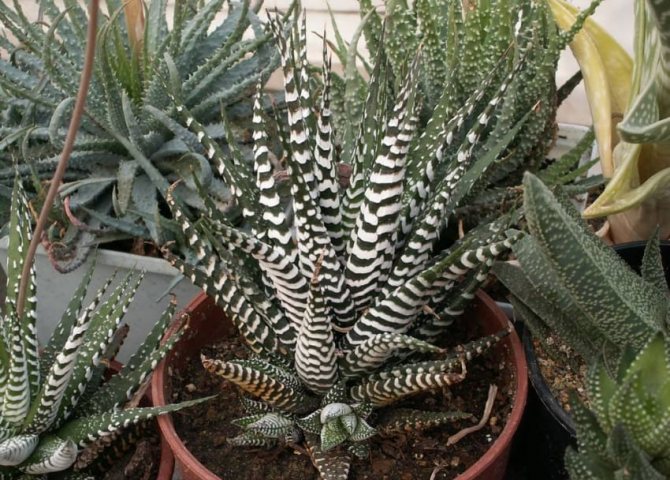

Possible difficulties and illnesses
Although Haworthia is considered an unpretentious crop, in some cases it can be exposed to diseases or pests. As a rule, this happens with improper plant care.
For example, if the roots or tips of the leaves dry out, this may indicate an increased moisture content in the substrate. In addition, the bush can grow crooked. This happens when it is unevenly lit. If you notice rotten or dark leaves, immediately revise the watering schedule, as your plant suffers from excessive moisture.
Of the pests, haworthia most often affect scale insects and mealybugs. If these insects are found, the leaves of the succulent should be washed with soapy water, and in case of mass damage, they should be treated with special insecticides.
You will find more detailed information about this amazing plant in the video.

